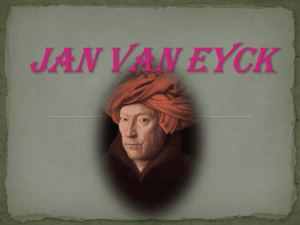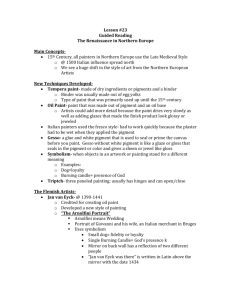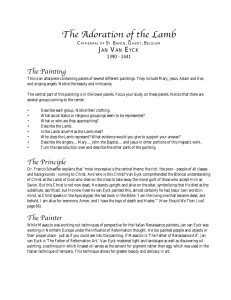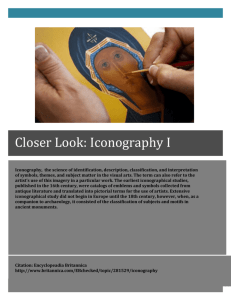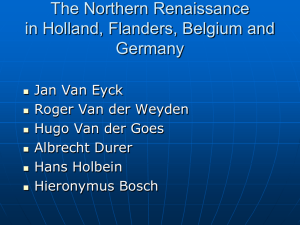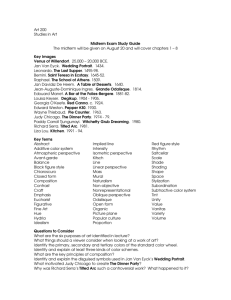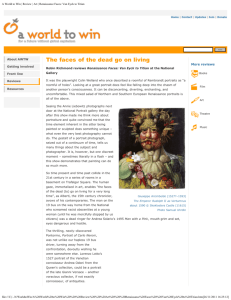Analysis Worksheet
advertisement
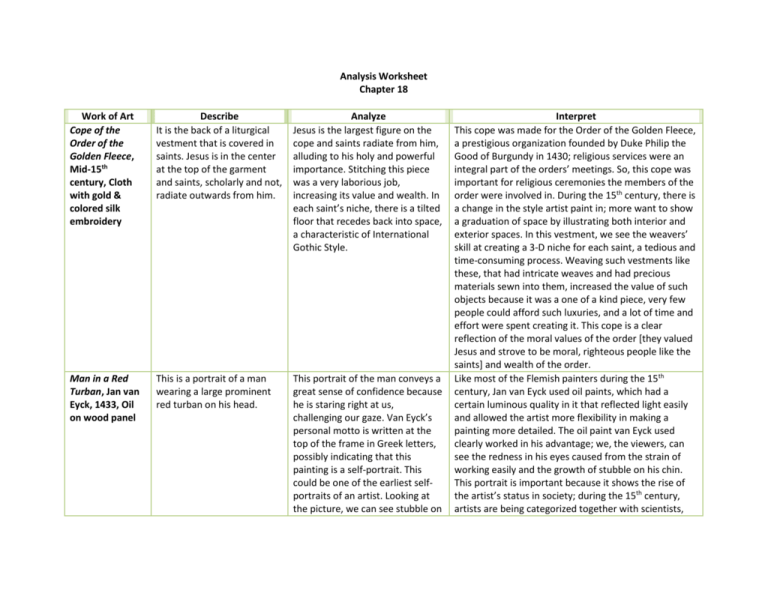
Analysis Worksheet Chapter 18 Work of Art Cope of the Order of the Golden Fleece, Mid-15th century, Cloth with gold & colored silk embroidery Describe It is the back of a liturgical vestment that is covered in saints. Jesus is in the center at the top of the garment and saints, scholarly and not, radiate outwards from him. Analyze Jesus is the largest figure on the cope and saints radiate from him, alluding to his holy and powerful importance. Stitching this piece was a very laborious job, increasing its value and wealth. In each saint’s niche, there is a tilted floor that recedes back into space, a characteristic of International Gothic Style. Man in a Red Turban, Jan van Eyck, 1433, Oil on wood panel This is a portrait of a man wearing a large prominent red turban on his head. This portrait of the man conveys a great sense of confidence because he is staring right at us, challenging our gaze. Van Eyck’s personal motto is written at the top of the frame in Greek letters, possibly indicating that this painting is a self-portrait. This could be one of the earliest selfportraits of an artist. Looking at the picture, we can see stubble on Interpret This cope was made for the Order of the Golden Fleece, a prestigious organization founded by Duke Philip the Good of Burgundy in 1430; religious services were an integral part of the orders’ meetings. So, this cope was important for religious ceremonies the members of the order were involved in. During the 15th century, there is a change in the style artist paint in; more want to show a graduation of space by illustrating both interior and exterior spaces. In this vestment, we see the weavers’ skill at creating a 3-D niche for each saint, a tedious and time-consuming process. Weaving such vestments like these, that had intricate weaves and had precious materials sewn into them, increased the value of such objects because it was a one of a kind piece, very few people could afford such luxuries, and a lot of time and effort were spent creating it. This cope is a clear reflection of the moral values of the order [they valued Jesus and strove to be moral, righteous people like the saints] and wealth of the order. Like most of the Flemish painters during the 15th century, Jan van Eyck used oil paints, which had a certain luminous quality in it that reflected light easily and allowed the artist more flexibility in making a painting more detailed. The oil paint van Eyck used clearly worked in his advantage; we, the viewers, can see the redness in his eyes caused from the strain of working easily and the growth of stubble on his chin. This portrait is important because it shows the rise of the artist’s status in society; during the 15th century, artists are being categorized together with scientists, the man’s cheek and wrinkles under the man’s eyes clearly, probably emphasized by the oil medium van Eyck used. A Double Portrait of a Giovanni Arnolfini and His Wife, Jan van Eyck, 1434, Oil on wood panel This double portrait shows a man, Giovanni Arnolfini, and his wife dressed in extravagant clothes holding hands tenderly in a room [a formal bedroom]. Theirs backs are reflected in the mirror that hangs on the back wall and holds the image of two people, possibly witnesses. Jan van Eyck signed the painting on the back wall of the room. Like most of northern Renaissance Flemish 15th-century paintings, this work is loaded with religious symbols that allude to marriage. First, the shoes lying to the left of Giovanni represent that since the couple has taken their shoes off, that this ceremony is a sacred occasion. The dog before their feet is a symbol of fidelity, a wish would-be-married couples would want to have in their marriage. The formal bedroom chamber also places this ceremony in a formal setting. The room and the patrons themselves are dressed luxuriously, alluding to the patrons’ wealth. The carved statue of the bedpost is a figure of St. Margaret, patron saint of pregnancy. In addition, the woman holds her dress over her belly like she is pregnant [maybe it could be a wish for the couple to have kids]. Finally, Jan van Eyck’s signature on the back wall and the two witnesses seen in the reflected image in the mirror philosophers, writers, etc. because artists are now thinkers and express their own theorems and ideas. By painting this portrait, Jan van Eyck introduced his new approach of painting a self-portrait [painting while looking at a self-reflected mirror] and his image to the world. Many art historians believe that this painting was either a physical “document” of a marriage or a proposal. The two patrons are shown [in large forms] in the center of the painting, alluding to their important stature. As I discussed in the analysis section, many symbols like the shoes, the dog, the statue of St. Margaret, and the hand holding, allude to marriage. Jan van Eyck uses oil paint, which gives his painting a luminous quality and allows him to paint details with more flexibility. His clear illustrations of the woman’s elaborate dress pattern, the transparency of the clear beads hanging on the wall, and medallions on the mirror show his deft skill. In addition, Flemish painters were known to paint mirrors to show more space and an alternate view of the scene; the mirror in this painting allows Jan van Eyck to show two people who wouldn’t be there without the mirror and adds to the overall mystery of the painting. This work, like other 15th century Northern Renaissance paintings, influenced the Italian Renaissance in the ways of portraying deep space, detail, and mediums. Work of Art Describe could allude to documentation of a marriage because there needs to be witnesses and proof that the two figures were wedded. Analyze Interpret Questions to consider when interpreting a work of art 1. 2. 3. 4. Who was it made for? A specific person, a particular market? This issue is broadly referred to as patronage. When was it made? What were the political, social, and economic conditions at the time? What artistic movements immediately preceded it and came after it? What artists influenced the work and what works did it go on to influence? Use this information in addition to the description and analysis to determine your interpretation.
